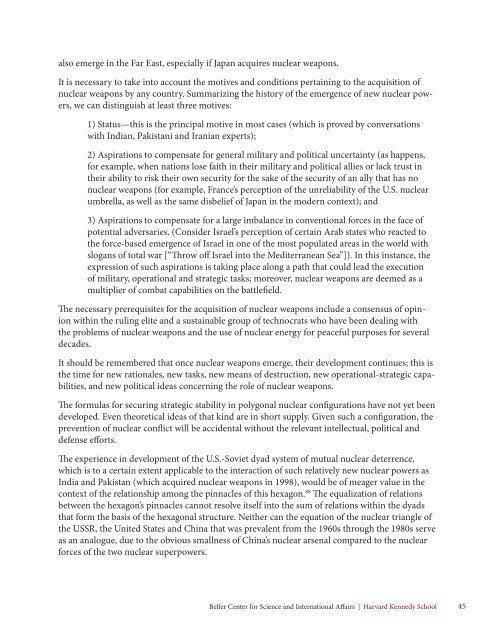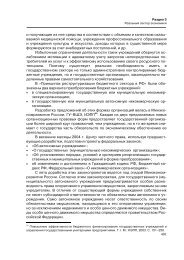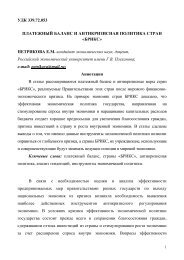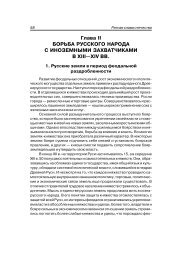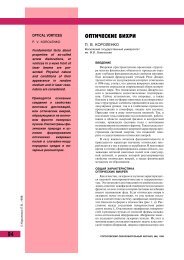Chapter 10: Challenges of Non-Proliferation of Nuclear Weapons, DeliveryVehicles <strong>and</strong> Fissile MaterialsIn <strong>the</strong> modern context, <strong>the</strong> problem of achiev<strong>in</strong>g non-proliferation objectives with respect tonuclear weapons, to <strong>the</strong>ir delivery vehicles, 83 <strong>and</strong> to <strong>the</strong> fissile materials that are produced <strong>in</strong> largequantities, has moved to <strong>the</strong> forefront of global politics as <strong>the</strong>y perta<strong>in</strong> to strategic stability.There is a real threat that nuclear weapons <strong>and</strong> fissile materials may fall <strong>in</strong>to <strong>the</strong> h<strong>and</strong>s of extremists.And here, <strong>the</strong> situation <strong>in</strong> Pakistan (which, accord<strong>in</strong>g to a number of authoritative estimates,has drastically <strong>in</strong>creased its nuclear potential) is a matter of special concern to <strong>the</strong> <strong>in</strong>ternationalcommunity. The consequences of a terrorist group us<strong>in</strong>g just one nuclear warhead are equitablydeemed as catastrophic, both for <strong>the</strong> victims of such mega-terror <strong>and</strong> for <strong>the</strong> entire global politicalsystem as a whole. This threat is still underestimated by a considerable part of <strong>the</strong> politicalelites <strong>in</strong> many countries. At a time when civilian use of nuclear power is on <strong>the</strong> rise <strong>in</strong> many partsof <strong>the</strong> world, <strong>the</strong> <strong>in</strong>ternational community is never<strong>the</strong>less fail<strong>in</strong>g to harden its nuclear-securitymeasures, which is mak<strong>in</strong>g it all <strong>the</strong> easier for a terrorist group to illicitly acquire fissile materialsthat could be used <strong>in</strong> <strong>the</strong> production of a nuclear bombs. 84The importance of this problem is reflected <strong>in</strong> <strong>the</strong> 2005 International Convention for <strong>the</strong> Suppressionof Acts of Nuclear Terrorism. This is <strong>the</strong> first anti-terrorist convention developed by <strong>the</strong><strong>in</strong>ternational community to prevent terrorist use of nuclear materials <strong>and</strong> o<strong>the</strong>r radioactive substances.The Convention first of all def<strong>in</strong>es radioactive <strong>and</strong> nuclear activities (pp. 1–2 of Article1). It specifies nuclear objects <strong>in</strong> detail. And <strong>the</strong>se are not just <strong>the</strong> nuclear reactors used at nuclearpower stations, but also <strong>the</strong> nuclear reactors deployed <strong>in</strong> various transport modalities, <strong>in</strong>clud<strong>in</strong>gsea vessels, aircraft <strong>and</strong> space-based systems) as a source of energy (pp. 3a of Article 1). Thus, <strong>the</strong>list of nuclear objects subject to protection has been considerably exp<strong>and</strong>ed.In conformity with this document, <strong>the</strong> signatories agree that any unlawful or <strong>in</strong>tentional possession<strong>and</strong> use of a radioactive material or a device conta<strong>in</strong><strong>in</strong>g radioactive substances with <strong>in</strong>tent tocause death or serious bodily <strong>in</strong>jury, substantial damage to property or to <strong>the</strong> environment shallbe deemed a crim<strong>in</strong>al offense on <strong>the</strong> part of any natural or legal person, <strong>in</strong>ternational organization,or state (pp. 1a, b of Article 2).Acquisition of nuclear-power status by new states may drastically complicate <strong>and</strong> perplex <strong>the</strong>entire system that currently provides for <strong>the</strong> secur<strong>in</strong>g of regional <strong>and</strong> global strategic stability.This perspective is absolutely realistic <strong>the</strong>se days, notwithst<strong>and</strong><strong>in</strong>g <strong>the</strong> efforts of <strong>the</strong> <strong>in</strong>ternationalcommunity. For example, acquisition of nuclear-missile weapons by Iran 85 would create a verycomplex <strong>in</strong>ter-regional, sub-global nuclear configuration—a sort of a hexagon formed by <strong>the</strong> nationsof Ch<strong>in</strong>a, India, Pakistan, Russia, Iran <strong>and</strong> Israel; 86 <strong>in</strong> this context, <strong>the</strong> <strong>in</strong>teractions among<strong>the</strong> elements of <strong>the</strong> hexagon will def<strong>in</strong>itely be <strong>in</strong>fluenced by <strong>the</strong> central nuclear balance betweenRussia <strong>and</strong> <strong>the</strong> United States that is <strong>the</strong> successor to <strong>the</strong> USSR-U.S. balance. (In this respect,<strong>the</strong>re is a high probability that Iran will be quickly followed by Saudi Arabia, which will becomea nuclear power by virtue of its long-term deep relations with Pakistan. 87 Thus, <strong>the</strong> hexagon mayturn <strong>in</strong>to a heptagon <strong>in</strong> <strong>the</strong> near future). In view of <strong>the</strong> development of nuclear-missile weaponsby North Korea <strong>and</strong> <strong>the</strong> nuclear status of Ch<strong>in</strong>a, a complex polygonal nuclear configuration may44<strong>Ensur<strong>in</strong>g</strong> <strong>Strategic</strong> <strong>Stability</strong> <strong>in</strong> <strong>the</strong> <strong>Past</strong> <strong>and</strong> <strong>Present</strong>: Theoretical <strong>and</strong> Applied Questions
also emerge <strong>in</strong> <strong>the</strong> Far East, especially if Japan acquires nuclear weapons.It is necessary to take <strong>in</strong>to account <strong>the</strong> motives <strong>and</strong> conditions perta<strong>in</strong><strong>in</strong>g to <strong>the</strong> acquisition ofnuclear weapons by any country. Summariz<strong>in</strong>g <strong>the</strong> history of <strong>the</strong> emergence of new nuclear powers,we can dist<strong>in</strong>guish at least three motives:1) Status—this is <strong>the</strong> pr<strong>in</strong>cipal motive <strong>in</strong> most cases (which is proved by conversationswith Indian, Pakistani <strong>and</strong> Iranian experts);2) Aspirations to compensate for general military <strong>and</strong> political uncerta<strong>in</strong>ty (as happens,for example, when nations lose faith <strong>in</strong> <strong>the</strong>ir military <strong>and</strong> political allies or lack trust <strong>in</strong><strong>the</strong>ir ability to risk <strong>the</strong>ir own security for <strong>the</strong> sake of <strong>the</strong> security of an ally that has nonuclear weapons (for example, France’s perception of <strong>the</strong> unreliability of <strong>the</strong> U.S. nuclearumbrella, as well as <strong>the</strong> same disbelief of Japan <strong>in</strong> <strong>the</strong> modern context); <strong>and</strong>3) Aspirations to compensate for a large imbalance <strong>in</strong> conventional forces <strong>in</strong> <strong>the</strong> face ofpotential adversaries. (Consider Israel’s perception of certa<strong>in</strong> Arab states who reacted to<strong>the</strong> force-based emergence of Israel <strong>in</strong> one of <strong>the</strong> most populated areas <strong>in</strong> <strong>the</strong> world withslogans of total war [“Throw off Israel <strong>in</strong>to <strong>the</strong> Mediterranean Sea”]). In this <strong>in</strong>stance, <strong>the</strong>expression of such aspirations is tak<strong>in</strong>g place along a path that could lead <strong>the</strong> executionof military, operational <strong>and</strong> strategic tasks; moreover, nuclear weapons are deemed as amultiplier of combat capabilities on <strong>the</strong> battlefield.The necessary prerequisites for <strong>the</strong> acquisition of nuclear weapons <strong>in</strong>clude a consensus of op<strong>in</strong>ionwith<strong>in</strong> <strong>the</strong> rul<strong>in</strong>g elite <strong>and</strong> a susta<strong>in</strong>able group of technocrats who have been deal<strong>in</strong>g with<strong>the</strong> problems of nuclear weapons <strong>and</strong> <strong>the</strong> use of nuclear energy for peaceful purposes for severaldecades.It should be remembered that once nuclear weapons emerge, <strong>the</strong>ir development cont<strong>in</strong>ues; this is<strong>the</strong> time for new rationales, new tasks, new means of destruction, new operational-strategic capabilities,<strong>and</strong> new political ideas concern<strong>in</strong>g <strong>the</strong> role of nuclear weapons.The formulas for secur<strong>in</strong>g strategic stability <strong>in</strong> polygonal nuclear configurations have not yet beendeveloped. Even <strong>the</strong>oretical ideas of that k<strong>in</strong>d are <strong>in</strong> short supply. Given such a configuration, <strong>the</strong>prevention of nuclear conflict will be accidental without <strong>the</strong> relevant <strong>in</strong>tellectual, political <strong>and</strong>defense efforts.The experience <strong>in</strong> development of <strong>the</strong> U.S.-Soviet dyad system of mutual nuclear deterrence,which is to a certa<strong>in</strong> extent applicable to <strong>the</strong> <strong>in</strong>teraction of such relatively new nuclear powers asIndia <strong>and</strong> Pakistan (which acquired nuclear weapons <strong>in</strong> 1998), would be of meager value <strong>in</strong> <strong>the</strong>context of <strong>the</strong> relationship among <strong>the</strong> p<strong>in</strong>nacles of this hexagon. 88 The equalization of relationsbetween <strong>the</strong> hexagon’s p<strong>in</strong>nacles cannot resolve itself <strong>in</strong>to <strong>the</strong> sum of relations with<strong>in</strong> <strong>the</strong> dyadsthat form <strong>the</strong> basis of <strong>the</strong> hexagonal structure. Nei<strong>the</strong>r can <strong>the</strong> equation of <strong>the</strong> nuclear triangle of<strong>the</strong> USSR, <strong>the</strong> United States <strong>and</strong> Ch<strong>in</strong>a that was prevalent from <strong>the</strong> 1960s through <strong>the</strong> 1980s serveas an analogue, due to <strong>the</strong> obvious smallness of Ch<strong>in</strong>a’s nuclear arsenal compared to <strong>the</strong> nuclearforces of <strong>the</strong> two nuclear superpowers.Belfer Center for Science <strong>and</strong> International Affairs | Harvard Kennedy School 45


